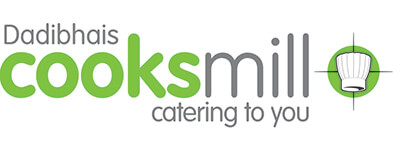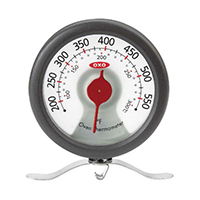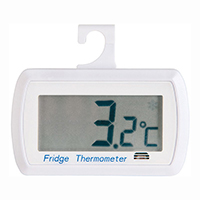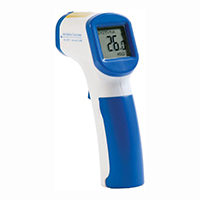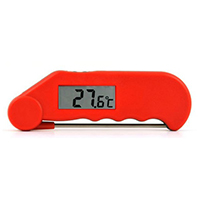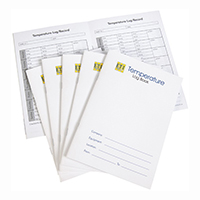Which Kitchen Thermometer? (Cooking the professional way)

In any professional kitchen, the tools you use are of vital importance. These might be the freshest ingredients, the best cookers, and importantly the perfect kitchen thermometer to make sure that every single dish you create is up to the desired temperature. When it comes to choosing a kitchen thermometer, there are many different types and styles to choose from - so it can be hard to pinpoint exactly what piece of equipment you need in a professional environment.
Here at Cooksmill, we've provided this easy and simple guide to educate you on everything kitchen thermometer. Read on to start learning more.
The different types of thermometers
The main type of kitchen cooking thermometer that you could see in a professional kitchen is an instant-read thermometer. Instant-read thermometers display the temperature of wherever the tip of the probe is placed at that particular moment.
Types of instant-read thermometers
There are various types of instant-read thermometers that you can buy. Here's a brief list of the main types:
-Food penetration probes. These are best for checking thin foods, as the probe is typically 1/8 of an inch in diameter. It's also known as a digital instant-read thermometer.
- Bimetal thermometers. While slower than other types of instant-read thermometers (producing readings in an average of 15-20 seconds), bimetal thermometers pose an advantage when it comes to reading the internal temperature of thicker foods, such as chicken breasts, thanks to a probe diameter of 2-3 inches thick.
- Thermometer/fork. Best for grilling foods, thermometer/fork combinations can provide readings in less than 10 seconds and are suitable for thick and thin foods alike. When reading thick foods such as meat, push the probe at least 0.25 inches into the thickest part in order to accurately gauge the internal temperature.
Which is the best meat thermometer?
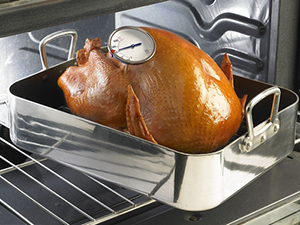
When it comes to cooking meat, you want to be using one of the following types of thermometer:
- Bimetal thermometers
- Thermometer/fork
You can also invest in specific meat roasting thermometers that also display the recommended internal temperatures of cooked meats.
Do professional chefs use meat thermometers?
Of course they do! If anything, more vigilantly than the average home cooker does. This is because undercooked or incorrectly cooked meat can still host harmful bacteria, such as E.coli, salmonella, and yersinia, which can have disastrous and occasionally fatal side-effects on the customers that consume them.
Though chefs are trained to spot by the naked eye when meat is cooked, they also use a meat thermometer for that extra security before carving and sending the food out.
Can you leave a food thermometer in the oven?
Most instant-read thermometers should not be left in the oven, as this would damage them. However, you can get thermometers such as the ETI oven thermometer that is safe for oven-use.
What are fridge and freezer thermometers used for?
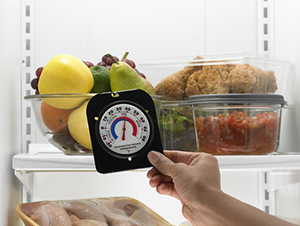
Fridges and freezers should each be kept at a minimum temperature for the safe storage of foods such as meat. Fridges should be kept at 4° C or below; freezers, -18° C. Professional kitchens can monitor the temperatures of their appliances by using fridge and freezer thermometers, which are placed inside the storage and can be checked at any time.
Using thermometers in food displays
If you're preparing a display of food such as meat or fish, you can use thermometers to show what temperature they're being stored at. Not only does this allow you to keep at eye on any deteriorating temperatures that may impact the quality of the food, but it also shows customers that their food is safe for them to consume.
Food probes vs infrared thermometers
The main difference between traditional food probes as mentioned above and more modern infrared thermometers is that infrared thermometers are a non-contact form of taking a temperature measurement; as they are non-contact, infrared thermometers can only measure the surface temperature of food and should not be used for the measurement of internal temperatures.
Infrared thermometers are ideal for foods where you do not wish the surface to be broken for the sake of presentation, such as delicate foods that do not require a minimum internal temperature to be reached.
Temperature logs in commercial premises
Commercial premises such as kitchens are required to keep a log of temperatures of appliances such as fridges and freezers. Fridges should be checked at least twice a day, while freezers should be checked at least once daily. Staff members need to log the temperature recordings each time they are checked, to demonstrate to Health & Safety inspectors that adequate food safety is being carried out while stored.
Shop Our Thermometers
How to shop with Cooksmill
The safety of both our valued customers and staff are at the forefront of our minds. As such we have carefully considered safety precautions in place. Our stores are open with social distancing measures in place to ensure it is safe to shop. Alternatively we also offer free collection from store and free delivery on all orders over £50. There are thousands of items available in our online shop with quick delivery!

